Effect of Loading Rate and Confining Pressure on Strength and Energy Characteristics of Mudstone under Pre-Cracking Damage
Abstract
:1. Introduction
2. Test Materials and Test Schemes
2.1. Sample Preparation
2.2. Test Scheme
3. Pre-Cracking Damage Analysis
3.1. Principle of Energy Dissipation
3.2. Establishment of Damage Degree Model Based on Energy Dissipation
4. Strength Characteristics under Pre-Cracking Damage Condition
4.1. Strength Characteristics Analysis
4.2. Characteristic Stress Analysis
5. Energy Characteristic under Pre-Cracking Damage Condition
5.1. Energy Evolution Characteristics under Different Loading Rates and Confining Pressures
5.2. Proportion of Elastic Strain Energy
6. Conclusions
- (1)
- The damage constitutive model of the mudstone specimen is established and verified by pre-cracking. The results show that the average damage degree D of the specimen is 0.12, and the model is reasonable.
- (2)
- Through triaxial mechanical experiments under different confining pressures W and loading rates S, the results show that under the same confining pressure W, the closed stress of mudstone increases gradually with the increase in loading rate S, and the closed stress has a good linear relationship with the loading rate S. Through the fitting relationship, it is found that the fitting correlation coefficient R, between the closed stress of mudstone and the loading rate S, is as high as 0.998.
- (3)
- Under the same confining pressure W, the energy absorbed by the rock sample is the largest when the loading rate S is 0.6 mm/min, and the energy absorbed by the rock sample decreases with the increase in the loading rate. The loading rate S at the turning point is 0.6 mm/min, indicating that the energy increases first and then decreases with the increase in the loading rate. The loading rate at the turning point is called the critical loading rate.
- (4)
- The proportion of elastic strain energy is used to analyze the dynamic process of the energy accumulation state of the specimen. It can be seen from the overall fitting curve that the elastic strain energy accumulation of the specimen presents a composite function of the exponential function of the natural constant e, and its change is obviously a nonlinear process.
Author Contributions
Funding
Institutional Review Board Statement
Informed Consent Statement
Data Availability Statement
Acknowledgments
Conflicts of Interest
References
- Xu, J.H.; Kang, Y.; Wang, X.C.; Feng, G.; Wang, Z.F. Dynamic characteristics and safety criterion of deep rock mine opening under blast loading. J. Int. J. Rock Mech. Min. 2019, 119, 156–167. [Google Scholar] [CrossRef]
- Li, X.B.; Weng, L. Numerical investigation on fracturing behaviors of deep-buried opening under dynamic disturbance. J. Tunn. Undergr. Sp. Technol. 2016, 54, 61–72. [Google Scholar] [CrossRef]
- Zhang, Q.; Wang, J.Q.; Guo, Y.M.; Chen, Y.; Sun, Q. Study on deformation and stress evolution law of surrounding rock under repeated mining in close coal seam. J. Energ. Source Part A 2020. [Google Scholar] [CrossRef]
- Jing, H.D.; Li, Y.H.; Li, K.M. Study on the Deformation Mechanism of Soft Rock Roadway under Blasting Disturbance in Baoguo Iron Mine. J. Shock Vib. 2018, 2018, 4349810. [Google Scholar] [CrossRef]
- Zhao, Q.C.; Fu, B.J.; Yin, J.D.; Wen, Z.J. Deformation Mechanism and Control Technology of the Surrounding Rock of the Floor Roadway under the Influence of Mining. J. Adv. Civ. Eng. 2020, 2020, 6613039. [Google Scholar] [CrossRef]
- Kan, J.G.; Wang, P.; Wang, P. Influencing Factors of Disturbance Effects of Blasting and Driving of Deep Mine Roadway Groups. J. Shock Vib. 2021, 2021, 8873826. [Google Scholar] [CrossRef]
- Tian, M.L.; Han, L.J.; Meng, Q.B.; Ma, C.; Zong, Y.J.; Mao, P.Q. Physical Model Experiment of Surrounding Rock Failure Mechanism for the Roadway under Deviatoric Pressure form Mining Disturbance. J. KSCE J. Civ. Eng. 2020, 24, 1103–1115. [Google Scholar] [CrossRef]
- Lai, X.P.; Xu, H.C.; Shan, P.F.; Kang, Y.L.; Wang, Z.Y.; Wu, X. Research on Mechanism and Control of Floor Heave of Mining-Influenced Roadway in Top Coal Caving Working Face. J. Energ. 2020, 13, 381. [Google Scholar] [CrossRef] [Green Version]
- Liu, X.S.; Song, S.L.; Tan, Y.L.; Fan, D.Y.; Ning, J.G.; Li, X.B.; Yin, Y.C. Similar simulation study on the deformation and failure of surrounding rock of a large section chamber group under dynamic loading. J. Int J. Min. Sci. Technol. 2021, 31, 495–505. [Google Scholar] [CrossRef]
- Bai, J.B.; Shen, W.L.; Guo, G.L.; Wang, X.Y.; Yu, Y. Roof Deformation, Failure Characteristics, and Preventive Techniques of Gob-Side Entry Driving Heading Adjacent to the Advancing Working Face. J. Rock Mech. Rock Eng. 2015, 48, 2447–2458. [Google Scholar] [CrossRef]
- Zang, C.W.; Chen, Y.; Chen, M.; Zhu, H.M.; Qu, C.M.; Zhou, J. Research on Deformation Characteristics and Control Technology of Soft Rock Roadway under Dynamic Disturbance. J. Shock Vib. 2021, 2021, 6625233. [Google Scholar] [CrossRef]
- Du, K.; Tao, M.; Li, X.B.; Zhou, J. Experimental Study of Slabbing and Rockburst Induced by True-Triaxial Unloading and Local Dynamic Disturbance. J. Rock Mech. Rock Eng. 2016, 49, 3437–3453. [Google Scholar] [CrossRef]
- Su, M.; Gao, X.H. Research of the Surrounding Rock Deformation Control Technology in Roadway under Multiple Excavations and Mining. J. Shock Vib. 2021, 2021, 6681184. [Google Scholar] [CrossRef]
- Zhang, L.M.; Gao, S.; Wang, Z.Q.; Ren, M.Y. Analysis on Deformation Characteristics and Energy Dissipation of Marble under Different Unloading Rates. Tehnički Vjesnik 2014, 21, 987–993. [Google Scholar]
- Wen, T.; Tang, H.M.; Ma, J.W.; Liu, Y.R. Energy Analysis of the Deformation and Failure Process of Sandstone and Damage Constitutive Model. J. KSCE J. Civ. Eng. 2019, 23, 513–524. [Google Scholar] [CrossRef]
- Wang, C.L.; He, B.B.; Hou, X.L.; Li, J.Y.; Liu, L. Stress-Energy Mechanism for Rock Failure Evolution Based on Damage Mechanics in Hard Rock. J. Rock Mech. Rock Eng. 2020, 53, 1021–1037. [Google Scholar] [CrossRef]
- Zhao, Z.H.; Ma, W.P.; Fu, X.Y.; Yuan, J.H. Energy theory and application of rocks. J. Arab. J. Geosci. 2019, 12, 474. [Google Scholar] [CrossRef]
- Hou, Z.K.; Gutierrez, M.; Ma, S.Q.; Almrabat, A. Mechanical Behavior of Shale at Different Strain Rates. J. Rock Mech. Rock Eng. 2019, 52, 3531–3544. [Google Scholar] [CrossRef]
- Huang, D.; Li, Y.R. Conversion of strain energy in Triaxial Unloading Tests on Marble. J. Int. J. Rock Mech. Min. 2014, 66, 160–3544. [Google Scholar] [CrossRef]
- Zhang, Y.B.; Zhao, T.B.; Taheri, A.; Tan, Y.L.; Fang, K. Damage characteristics of sandstone subjected to pre-peak and post-peak cyclic loading. J. Acta Geodyn. Geomater. 2019, 16, 143–150. [Google Scholar] [CrossRef]
- Martin, C.D. The Strength of Massive Lac du Bonnet Granite around Underground Openings. Ph.D. Thesis, University of Manitoba, Winnipeg, MB, Canada, 1993. [Google Scholar]
- Eberhardt, E. Brittle Rock Fracture and Progressive Damage in Uniaxial Compression. Ph.D. Thesis, University of Saskatchewan, Saskatoon, SK, Canada, 1998. [Google Scholar]
- Cai, M.F.; He, M.C.; Liu, D.Y. Rock Mechanics and Engineering Science Press, 2nd ed.; Sciences Publishing House: Beijing, China, 2013; pp. 63–64. [Google Scholar]
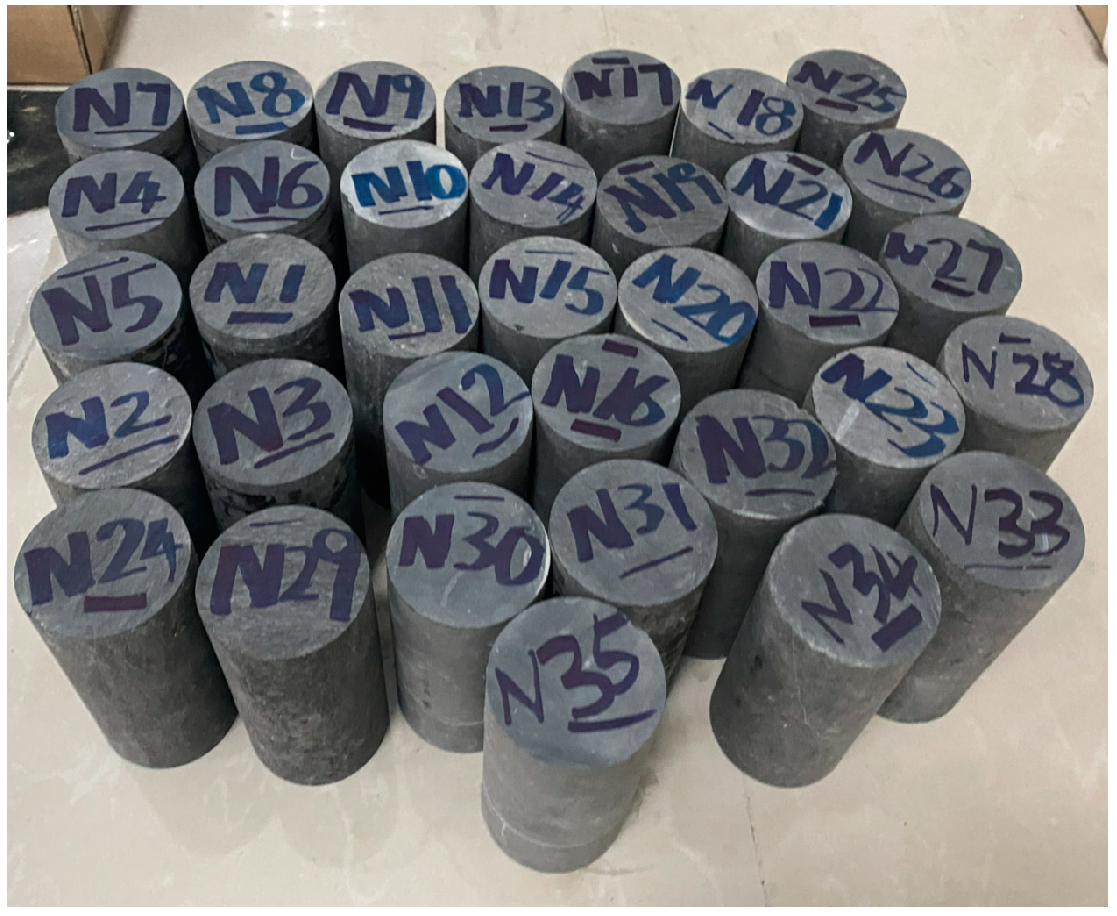
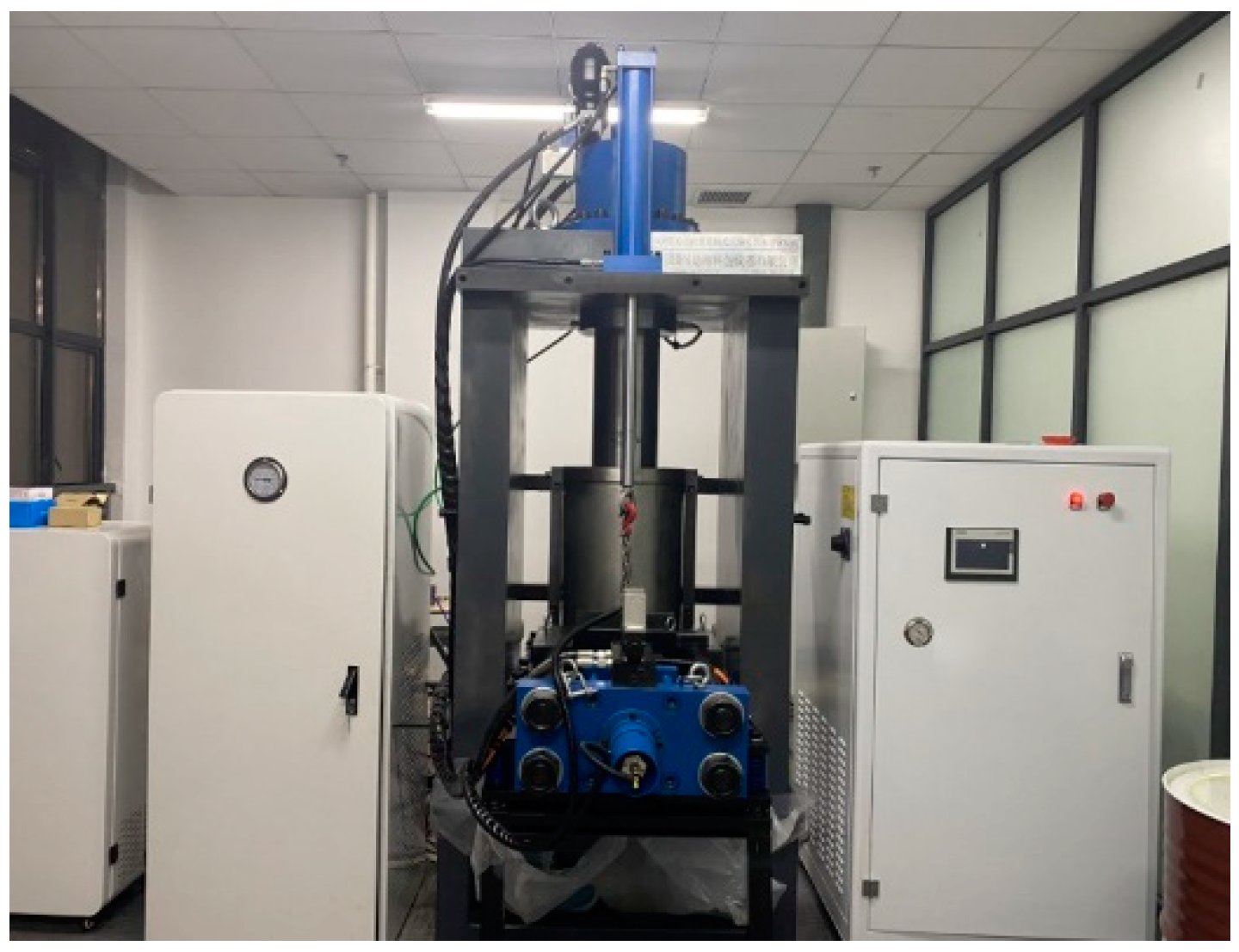
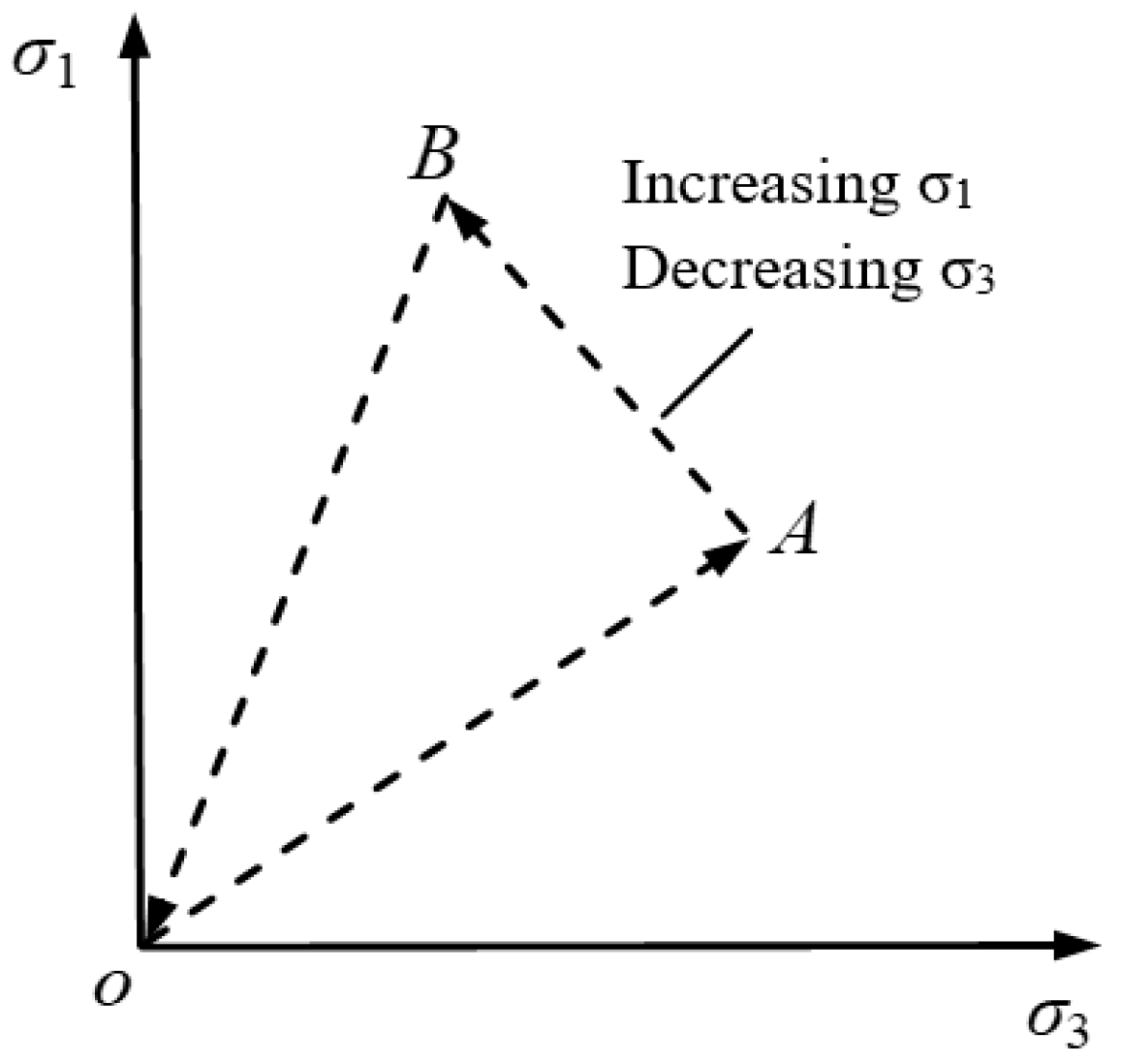


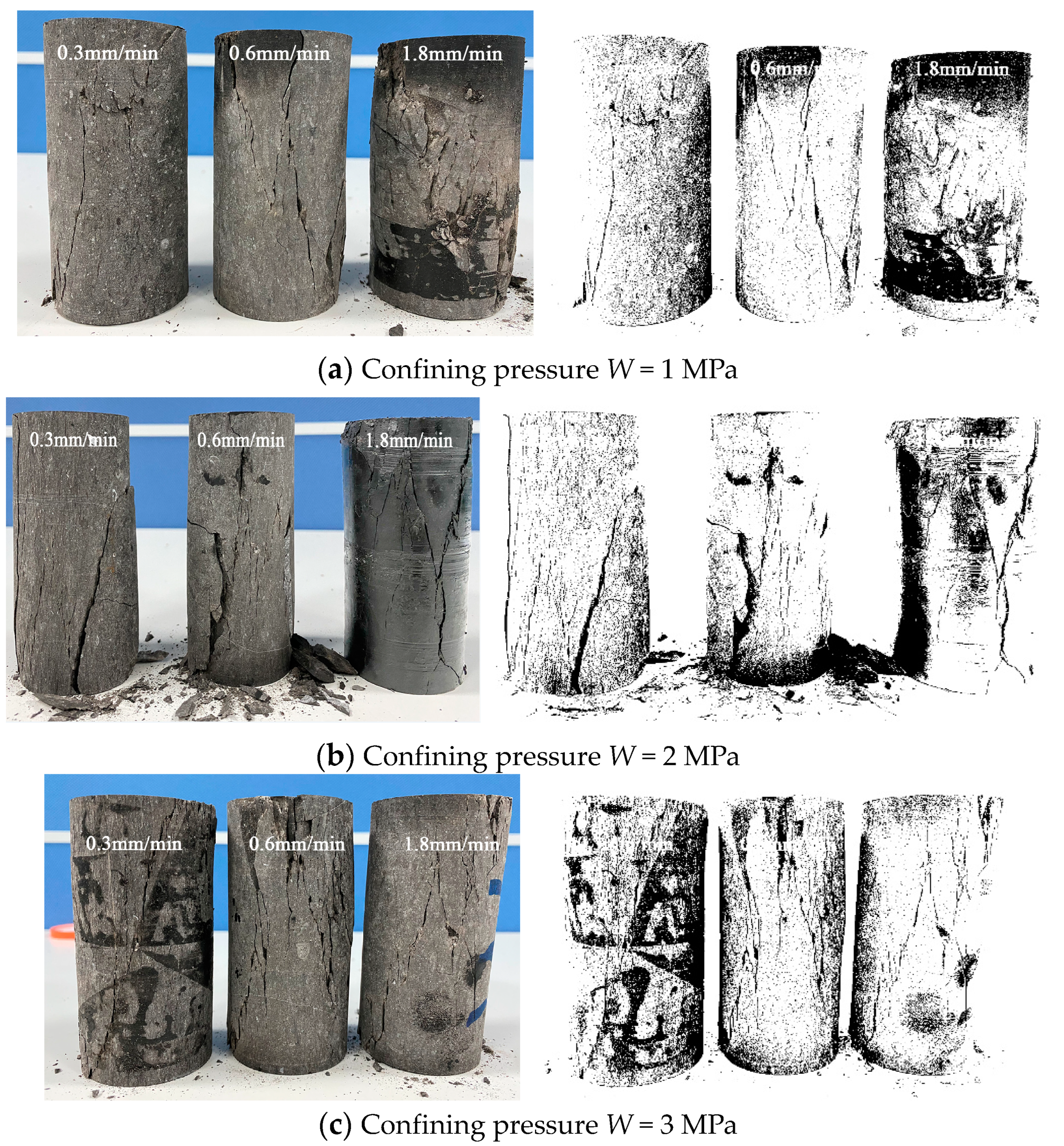
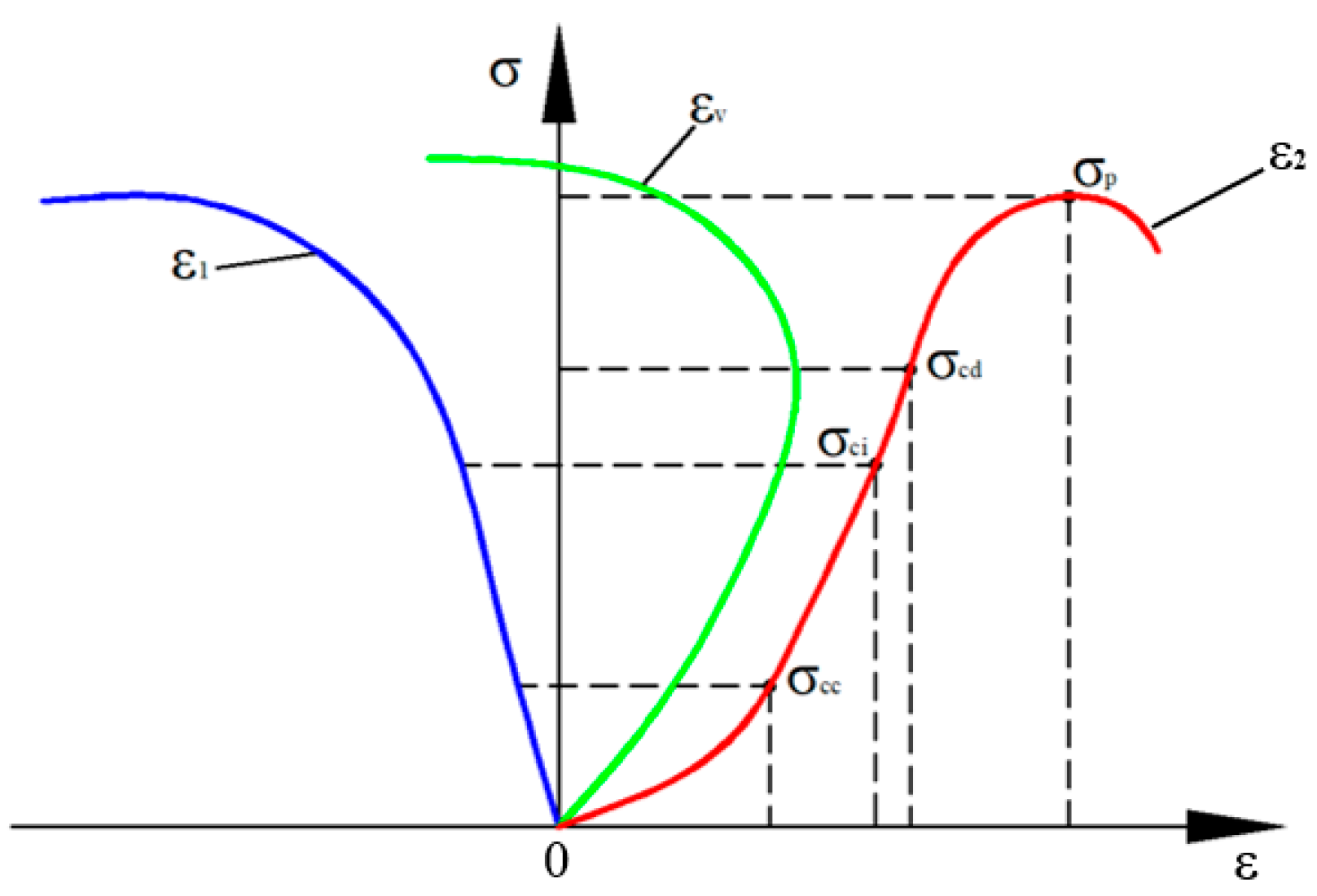

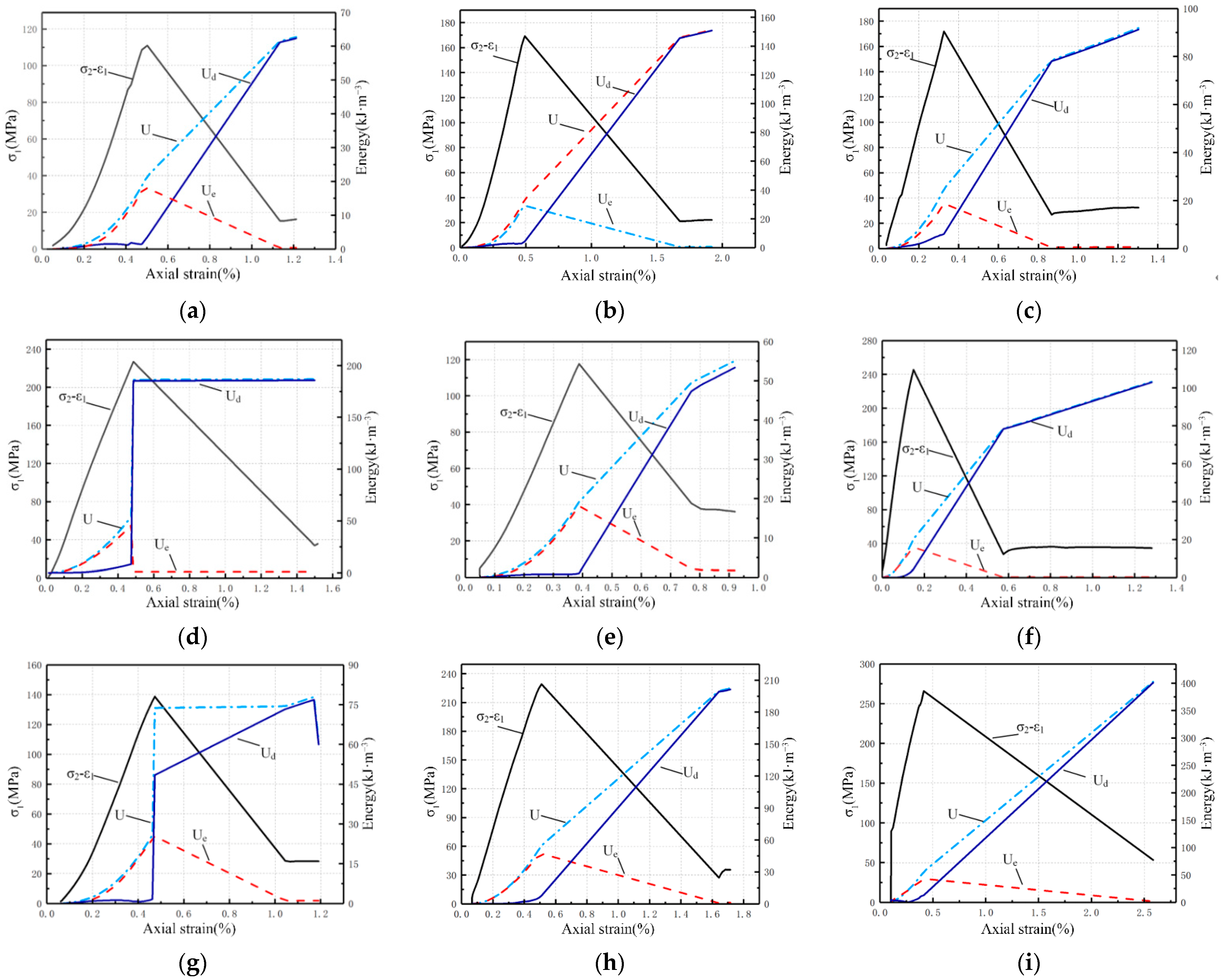
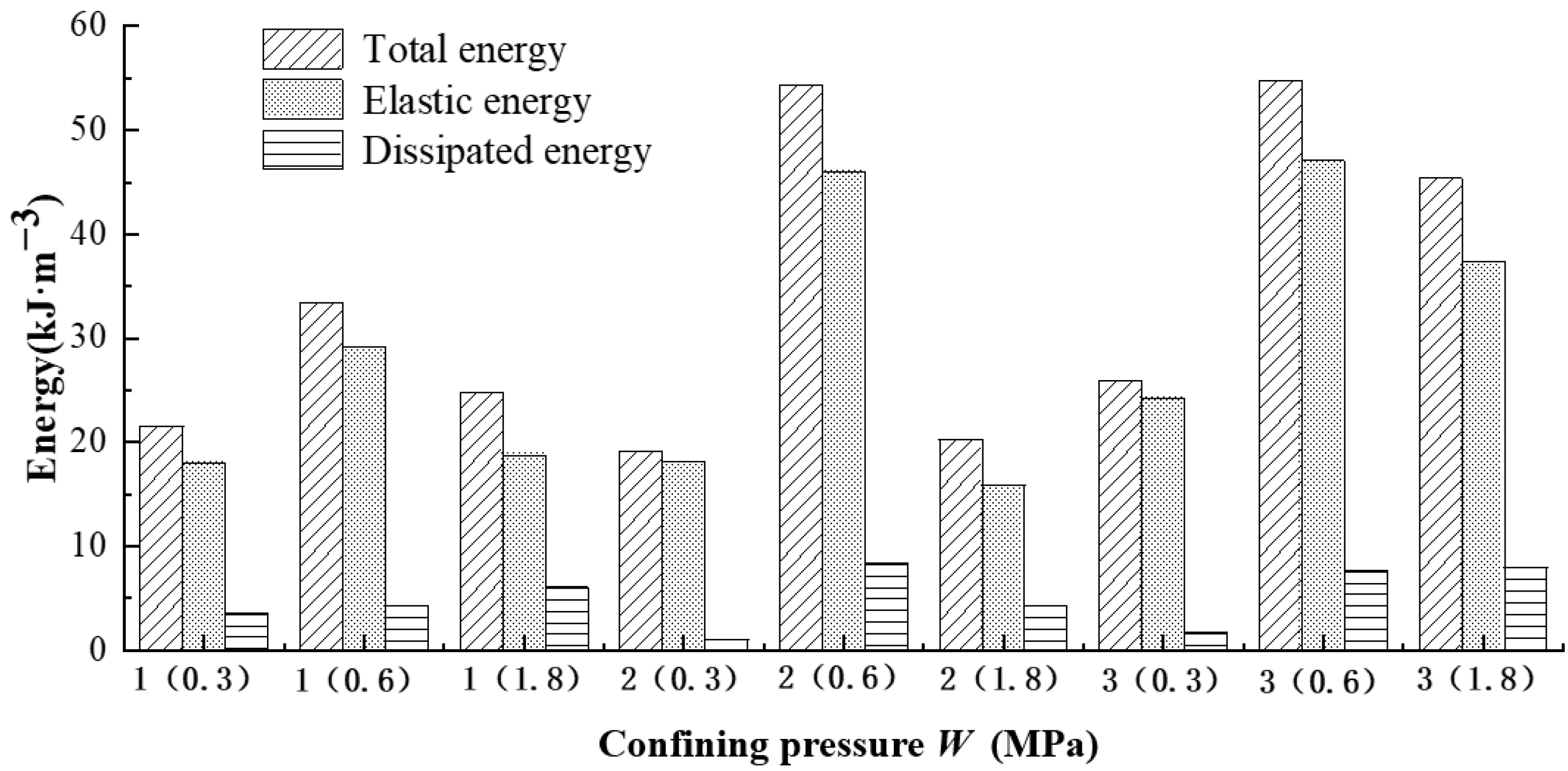
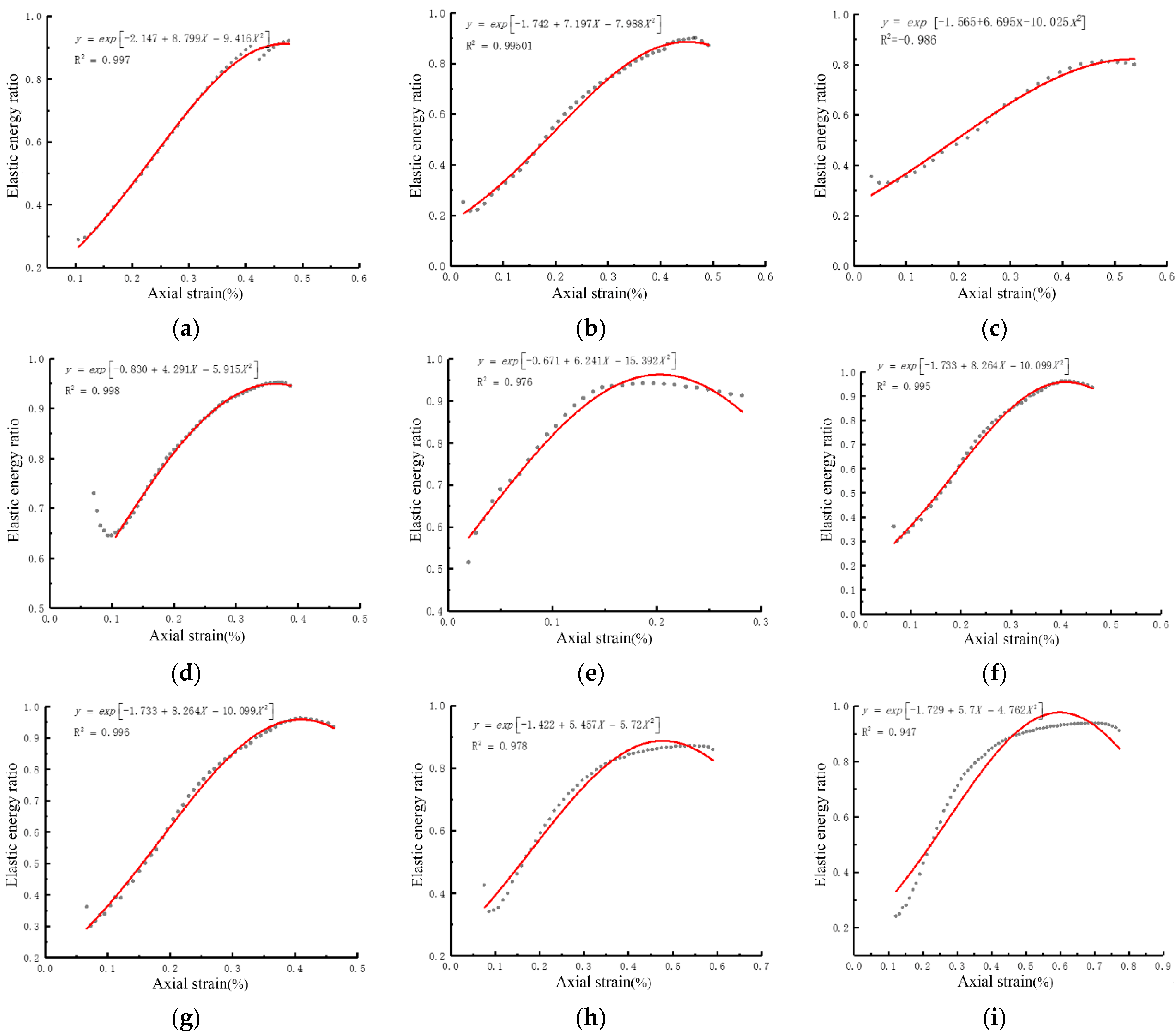
| Sample No | Confining Pressure /MPa | Loading Rate /mm min−1 | Peak Strength /MPa | Elastic Modulus /GPa |
|---|---|---|---|---|
| 1 | 1.0 | 0.3 | 110.96 | 34.2 |
| 2 | 1.0 | 0.6 | 169.18 | 49.17 |
| 3 | 1.0 | 1.8 | 171.83 | 58.74 |
| 4 | 2.0 | 0.3 | 117.67 | 38.2 |
| 5 | 2.0 | 0.6 | 226.88 | 46.65 |
| 6 | 2.0 | 1.8 | 245.45 | 53.95 |
| 7 | 3.0 | 0.3 | 138.7 | 37.96 |
| 8 | 3.0 | 0.6 | 229.15 | 55.84 |
| 9 | 3.0 | 1.8 | 265.86 | 62.08 |
Publisher’s Note: MDPI stays neutral with regard to jurisdictional claims in published maps and institutional affiliations. |
© 2022 by the authors. Licensee MDPI, Basel, Switzerland. This article is an open access article distributed under the terms and conditions of the Creative Commons Attribution (CC BY) license (https://creativecommons.org/licenses/by/4.0/).
Share and Cite
Zheng, H.; Ma, Z.; Zhou, L.; Zhang, D.; Liang, X. Effect of Loading Rate and Confining Pressure on Strength and Energy Characteristics of Mudstone under Pre-Cracking Damage. Energies 2022, 15, 3545. https://doi.org/10.3390/en15103545
Zheng H, Ma Z, Zhou L, Zhang D, Liang X. Effect of Loading Rate and Confining Pressure on Strength and Energy Characteristics of Mudstone under Pre-Cracking Damage. Energies. 2022; 15(10):3545. https://doi.org/10.3390/en15103545
Chicago/Turabian StyleZheng, Hanghang, Zhenqian Ma, Lang Zhou, Dongyue Zhang, and Xuchao Liang. 2022. "Effect of Loading Rate and Confining Pressure on Strength and Energy Characteristics of Mudstone under Pre-Cracking Damage" Energies 15, no. 10: 3545. https://doi.org/10.3390/en15103545






